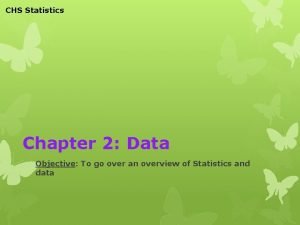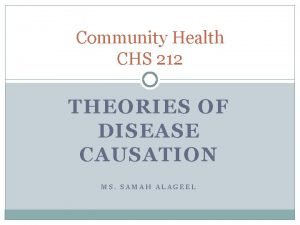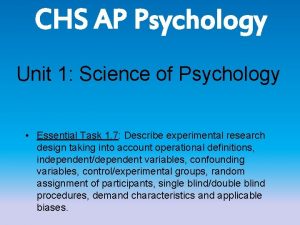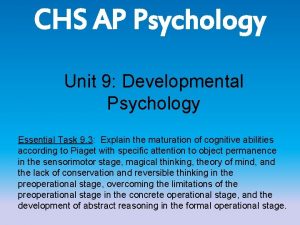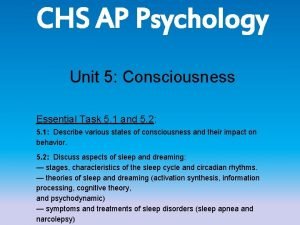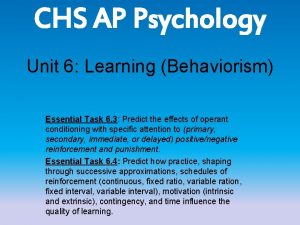CHS AP Psychology Unit 1 Science of Psychology
























- Slides: 24

CHS AP Psychology Unit 1: Science of Psychology • Essential Task 1 -8: Apply basic statistical concepts to explain research findings: - Descriptive Statistics: Central Tendency (mean, median, mode, skewed distributions) Variance ( range, standard deviation, and normal distributions) – Inferential Statistics: Statistical significance (t-test and p-value)

Statistical Reasoning Statistical procedures analyze and interpret data and let us see what the unaided eye misses. Composition of ethnicity in urban locales

Central Tendency • Tendency of scores to congregate around some middle variable • A measure of central tendency identifies what is average or typical in a data set

Measures of Central Tendency Mode: The most frequently occurring score in a distribution. Mean: The arithmetic average of scores in a distribution obtained by adding the scores and then dividing by their number. Median: The middle score in a rankordered distribution.

But the mean doesn‘t work in a skewed distribution… The median is a much better measure of the center

Skewed distributions Look for the “tail of the whale” Negatively Skewed zero • If the tail is closest to ZERO, it is negatively skewed. • If it is far away from ZERO, it is positively skewed. Positively Skewed zero

Measures of Variation • Statistical dispersion (how distributed the data points are) is a key concept in statistics. • Two key ways of measuring statistical dispersion Ø Range Ø Standard Deviation

Range The range simply gives the lowest and highest values of a data set.

Let’s Roll the Dice! • Get into pairs, and one person gets out a piece of paper and writing utensil and the other gets the 2 dice • Writing utensil partner will create this chart: Score Frequency 2 3 4 5 6 7 8 9 10 11 12 frequency score The best way to show this data is to use a bar graph

Standard Deviation • Standard deviation gives a measure of dispersion. – Essentially, they are measures of the average difference between the values. • Standard deviation gives a value that is directly comparable to your mean values.

Standard Deviation in Action • A couple needs to be within one standard deviation of each other in intelligence (10 points in either direction). —Neil Clark Warren, founder of e. Harmony. com

Formulas for Standard Deviation You will NOT need to know this for the test. This is just to show you how it is formulated to use in statistical research

Normal Distributions • The distribution of data also gives us key info. • We know that many human attributes… e. g height, weight, task skill, reaction time, anxiousness, personality characteristics, attitudes etc. • …follow a normal distribution.

Normal Distribution

IQ follows a Normal Distribution You NEED to memorize this! We’ll touch on it again in the Individual Differences Unit! Mean = 100 SD = 15

What percentage score below 100? Mean = 100 SD = 15 2. 1% 13. 6% 34. 1%

What percentage score above 100? Mean = 100 SD = 15 34. 1% + 13. 6% + 2. 1%

Statistical Significance • How two groups’ means are different – If graphed data does not overlap or overlaps a bit, difference IS SIGNIFICANT • Significance allows you to say how likely the difference in the means is due to CHANCE – Goal is. 05 difference, or 5% due to chance, which isn’t a lot • If it end up. 75 difference, the more chance affected the outcome. – The larger the number, the more likely chance had to do with the difference in the outcomes.

Normal Distribution

What percentage score between 85 and 100? 34. 1% Mean = 100 SD = 15

Normal Distribution

What percentage score between 85 and 115? Mean = 100 SD = 15 34. 1% + 34. 1% = 68. 2%

What percentage score between 70 and 130? Mean = 100 SD = 15 13. 6% + 34. 1% + 13. 6% = 95. 4%

What percentage score below 70 and above 130? Mean = 100 SD = 15
 Chs lancers
Chs lancers Creative house scaffolding
Creative house scaffolding Chs vs ibs
Chs vs ibs Chs statistics
Chs statistics St robert ib boundary
St robert ib boundary Example of chs theories
Example of chs theories Chs module
Chs module Parasitism
Parasitism Chs investigations
Chs investigations Cms.edf.school
Cms.edf.school Middle school classes
Middle school classes Cylinder dysku
Cylinder dysku Chs investigations
Chs investigations My favorite subject is
My favorite subject is Unit 10, unit 10 review tests, unit 10 general test
Unit 10, unit 10 review tests, unit 10 general test Natural vs social science
Natural vs social science Different branches of science
Different branches of science Natural science vs physical science
Natural science vs physical science Applied science vs pure science
Applied science vs pure science Rapid change
Rapid change Science fusion think central
Science fusion think central Rule of 70 population growth
Rule of 70 population growth Windcube
Windcube Hard science and soft science
Hard science and soft science Operational definition in psychology
Operational definition in psychology



